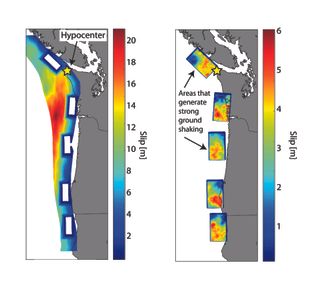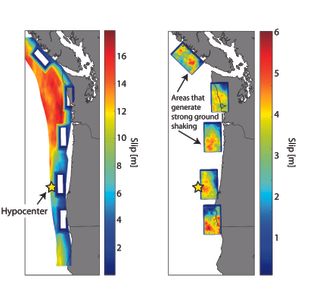What If a 9.0-Magnitude Earthquake Hit Seattle?
The simulations don't paint a pretty picture for Seattle or the coastal areas of Washington, Oregon, British Columbia and Northern California, but the locations of some epicenters were a bit more forgiving than others.
"People have done simulations like this in the past, but they only did one or two," said study lead researcher Erin Wirth, who did the project while a postdoctoral researcher in the Department of Earth and Space Sciences at the University of Washington. "In running 50 [simulations], we were trying to show the full range of possibilities by varying all these parameters." [The 10 Biggest Earthquakes in History]
The Pacific Northwest is in earthquake country largely because of the Cascadia Subduction Zone (CSZ), a 620-mile-long (1,000 kilometers) fault stretching from northern Vancouver Island, Canada, to Cape Mendocino, California, according to the Pacific Northwest Seismic Network. At the fault line, the offshore Juan de Fuca plate is moving toward, and eventually under, the plate holding the continent of North America. (There are other active faults in the Pacific Northwest, but the CSZ is capable of triggering the strongest earthquakes, according to the Washington State Department of Natural Resources.)
"We know that Cascadia is capable of having large megathrust earthquakes up to about magnitude 9," said Wirth, who is now a research geophysicist at the U.S. Geological Survey (USGS). "The last one occurred in the year 1700. Obviously, we didn't have any seismometers to record the shaking then, so we really don't know what it looked like in terms of the intensity of ground shaking."

To investigate the effects of a 9.0-magnitude earthquake, Wirth and her colleagues ran virtual simulations on supercomputers. For each simulation, they randomly changed three variables: the location of the earthquake's starting point at ground level, known as the epicenter; how far inland the earthquake ruptured (i.e., how close it got to major inland cities, such as Seattle and Portland, Oregon); and the location of strong patches, or places that are known to produce especially strong ground shaking.
Over the course of the 50 simulations, "we always saw the strongest shaking along the coast, since they are closest to the offshore fault," Wirth told Live Science. There was also consistently strong shaking in areas on top of sedimentary basins, which are basins filled with layers of different sediments, including the Seattle basin.
"That kind of weak material tends to make the ground shake more," Wirth said. "People like to describe it as sitting on top of a bowl of Jell-O. You can imagine if you shake a plate that has some Jell-O on it, the Jell-O will shake much more [than the plate] because it's so weak."
Sign up for the Live Science daily newsletter now
Get the world’s most fascinating discoveries delivered straight to your inbox.
The Jell-O-like Seattle basin could have a long-lasting earthquake, the researchers found. "The average duration of strong shaking in Seattle is about 100 seconds, about four times as long as from the 2001 Nisqually earthquake," the magnitude 6.8 earthquake that rattled the Seattle region, study collaborator Art Frankel, a USGS seismologist and affiliate faculty member at the University of Washington, said in a statement.
Rupture away
Seattle could escape catastrophic damage if the conditions are right. If the epicenter is located just beneath the tip of northwest Washington, its seismic waves would radiate away from the Emerald City.
"The reason is because [at this epicenter] the rupture is propagating away from Seattle, so it's most affecting sites offshore," Wirth said in the statement. "But when the epicenter is located pretty far offshore, the rupture travels inland, and all of that strong ground shaking piles up on its way to Seattle, to make the shaking in Seattle much stronger." [Image Gallery: This Millennium's Destructive Earthquakes]
The findings also showed that when an earthquake ruptures farther inland, big cities such as Seattle and Portland experience stronger shaking.
Moreover, places close to strong patches also experience strong shaking. "But we don't know where these patches will be," Wirth told Live Science. "We varied it randomly in our simulations."

Engineers at the University of Washington are now looking at these results and figuring out how the buildings in Seattle would weather the shaking predicted in the simulations, Wirth said. They're also taking into account that the shaking can vary by about a factor of 10, "depending on where the earthquake started or how close you were to one of those strong patches on the fault," Wirth said.
It's impossible to predict earthquakes with current technology, but the Pacific Northwest isn't due for a big earthquake quite yet. The CSZ has a big earthquake about once every 500 years, and it's been about 300 years since the last big one, Wirth said.
"It's just important to be aware that we have this earthquake hazard in the Pacific Northwest," she said. "Have your earthquake kit and know what you would do in an earthquake. That's the best we can do."
The research, which has yet to be published in a peer-reviewed journal, was presented Oct. 24 at the 2017 Geological Society of America's annual meeting in Seattle.
Original article on Live Science.

Laura is the archaeology and Life's Little Mysteries editor at Live Science. She also reports on general science, including paleontology. Her work has appeared in The New York Times, Scholastic, Popular Science and Spectrum, a site on autism research. She has won multiple awards from the Society of Professional Journalists and the Washington Newspaper Publishers Association for her reporting at a weekly newspaper near Seattle. Laura holds a bachelor's degree in English literature and psychology from Washington University in St. Louis and a master's degree in science writing from NYU.

